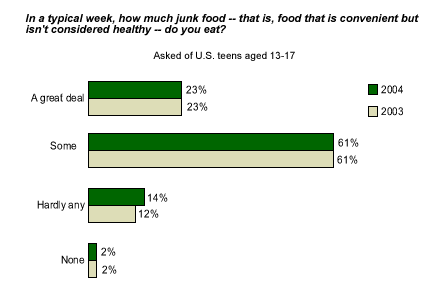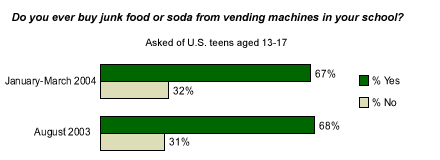School districts throughout the nation are wrestling with the dilemma of whether to eliminate vending machines that contain soda and other junk food from their schools, despite high student demand, in an effort to promote better nutritional choices for kids. According to a recent ║┌┴¤═° Youth Survey of 13- to 17-year-olds*, the vast majority of teens report eating either "some" (61%) or "a great deal" (23%) of junk food in a typical week. In answer to a separate question, nearly 7 in 10 teens (67%) say they have purchased junk food or soda from school vending machines.
As childhood obesity continues to rise, reducing students' access to junk food is a positive step, but it clearly cannot stop the consumption, or address the issue of physical fitness. School districts across the country have gradually been removing junk food from vending machines over the past several months, but ║┌┴¤═° data show no reduction in reported teen consumption of junk food since the last time it was asked about in August 2003.


Differences in the data illustrate the vicious cycle that must be broken: Teens who probably need to curb their consumption of junk food the most -- those who are overweight or say they want to lose weight -- are more likely to purchase and regularly consume junk food than those who do not report weight concerns. Three-quarters (75%) of teens who describe themselves as overweight say they buy junk food or soda at school, compared with 65% of those who feel that they are either underweight or about right. And three-quarters (75%) of those who want to lose weight say that they purchase junk food and soda at school, compared with 65% of those who do not desire weight loss.
Surprisingly, the data show no differences in the purchase of junk food based on reported levels of exercise. Teens who are considered serious exercisers are just as likely as couch potatoes to say that they purchase junk food or soda from vending machines in school.
Teen girls are about as likely as boys to buy junk food or soda from vending machines (69% and 66%, respectively), and there is no difference by gender in consumption of such foods in a typical week.
Bottom Line
A new study just published in the Journal of the American Medical Association has found an alarming increase in blood pressure levels among young Americans, and the report suggests that poor diet and lack of exercise are major contributors to this trend. The study recommends fighting high blood pressure among the nation's youth with "programs that include weight control, increased physical activity, and changes in diet." The report also points to sweetened carbonated soda, widely available to most kids in school and at home, as potentially playing a role in increasing blood pressure -- particularly among black youth.
With so much evidence pointing to poor diet and exercise habits as causes of rising obesity rates among American youth, it has never been more important to persuade young people of the benefits of a healthy lifestyle. It is unclear the extent to which eliminating junk food machines in schools will help, but there is no question that reducing teen consumption of junk food in any capacity can't hurt. Indeed, a new study in the British Medical Journal suggests that even a modest reduction -- less than one can of sweetened carbonated soda a day -- helped elementary school kids lose weight.
*The ║┌┴¤═° Youth survey is conducted via an Internet methodology provided by Knowledge Networks, using an online research panel that is designed to be representative of the entire U.S. population. The current questionnaire was completed by 785 respondents, aged 13 to 17, between Jan. 22 and March 9, 2004. For results based on the total sample, one can say with 95% confidence that the maximum margin of sampling error is ±4 percentage points.